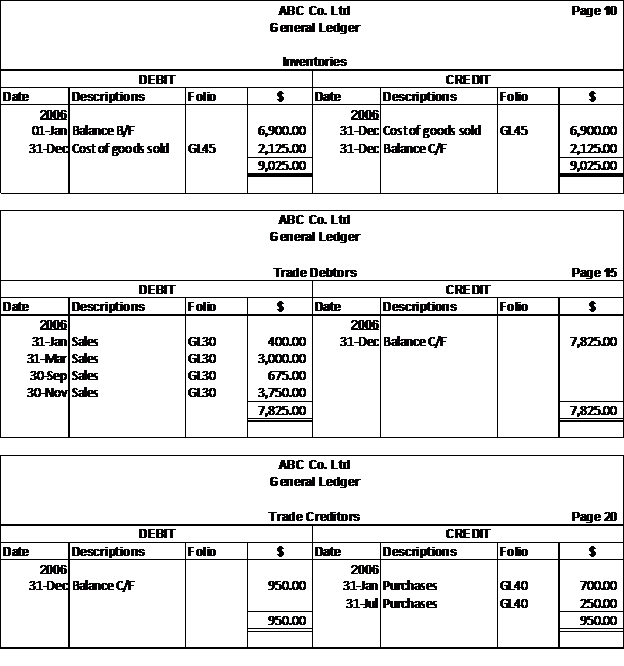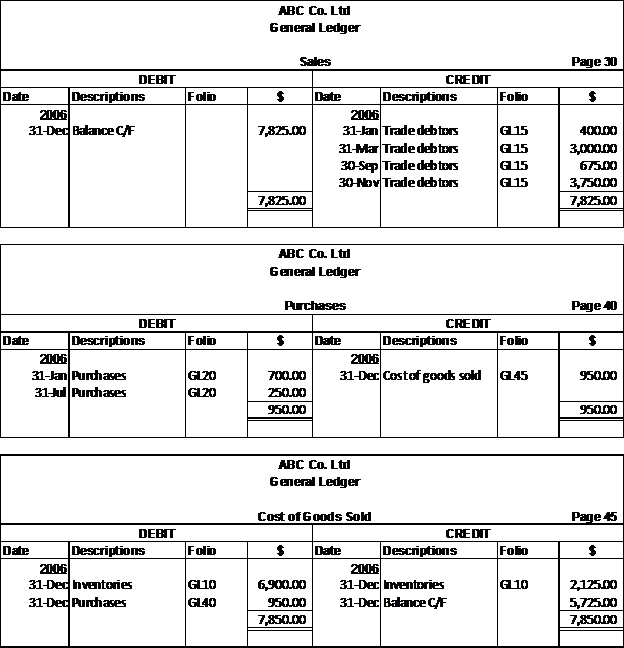There are two common methods of recording inventories or stocks in the General Ledger of business entities:-
1. The Periodic Method2. The Perpetual MethodThe choice of the method used will directly determine the double entries for the recording of inventories or stocks of the entity concerned.1. The Periodic MethodUnder this method, the inventories or stocks account in the General Ledger would not be updated regularly with the movement of inventories or stocks throughout the whole financial period until the last closing day of the financial period in which the new inventories balance would be determined and adjusted accordingly. The balance of the inventories or stocks account remained at the amount brought forward from the previous financial period i.e. the opening inventories or stocks for the current financial period (this is also the closing balance of inventories or stocks for the previous financial period). At the end of the current financial period, an inventories counting exercise would be conducted to determine the closing balance of inventories and once this is done, the inventories or stocks account in the General Ledger would then be adjusted to reflect the correct inventories or stocks balance on the closing date. On the closing date (i.e. the end of the current financial period), the cost of goods sold would also be determined and deducted against the sales or turnover figure recorded for the current financial period to get the gross profit amount. The steps involved are explained in the following illustration:-
Example 1Assume the following information for ABC Co. Ltd for the financial year ended 31 December 2006 (i.e. the financial period is for 12 months from 1 January 2006 to 31 December 2006):-
a. Inventories or stocks on hand as at 31 December 2005 comprised the following: -Quantity | Unit Cost | Total | |
$ | $ | ||
Stock Type A | 100 | 5 | 500 |
Stock Type B | 200 | 7 | 1,400 |
Stock Type C | 250 | 20 | 5,000 |
6,900 |
a. No double entry required. The transactions had been recorded in the General Ledger in the previous financial year.
b. 15 January 2006
Balance Sheet | Income Statement | |||
DR | CR | DR | CR | |
| 31 January 2006 | ||||
| Trade debtors | 400 | |||
| Sales | 400 | |||
| (Sales for January 2006) | ||||
c. 20 January 2006
Balance Sheet | Income Statement | |||
DR | CR | DR | CR | |
| 31 January 2006 | ||||
| Purchases | 700 | |||
| Trade creditors | 700 | |||
| (Purchases for January 2006) | ||||
d. 21 March 2006
Balance Sheet | Income Statement | |||
DR | CR | DR | CR | |
| 31 March 2006 | ||||
| Trade debtors | 3,000 | |||
| Sales | 3,000 | |||
| (Sales for March 2006) | ||||
e. 31 July 2006
Balance Sheet | Income Statement | |||
DR | CR | DR | CR | |
| 31 July 2006 | ||||
| Purchases | 250 | |||
| Trade creditors | 250 | |||
| (Purchases for July 2006) | ||||
f. 30 September 2006
Balance Sheet | Income Statement | |||
DR | CR | DR | CR | |
| 30 September 2006 | ||||
| Trade debtors | 675 | |||
| Sales | 675 | |||
| (Sales for September 2006) | ||||
g. 30 November 2006
Balance Sheet | Income Statement | |||
DR | CR | DR | CR | |
| 30 November 2006 | ||||
| Trade debtors | 3,750 | |||
| Sales | 3,750 | |||
| (Sales for November 2006) | ||||
Table 1 | Stock Type A | Stock Type B | Stock Type C |
Quantity | Quantity | Quantity | |
| Balance as at 1 January 2006 | 100 | 200 | 250 |
| Stock in: | |||
| 20 January 2006 | 100 | ||
| 31 March 2006 | 50 | ||
| Stock out: | |||
| 15 January 2006 | (50) | ||
| 21 March 2006 | (300) | ||
| 30 September 2006 | (75) | ||
| 30 November 2006 | (150) | ||
| Balance as at 31 December 2006 | 25 | - | 100 |
Note: In this example, the cost of purchases of inventories during the year was intentionally fixed to remain the same as those as at 1 January 2006 for the purpose of simplifying the illustration of this topic. For Type A stock, the purchase of inventories made on 31 March 2006 was at $5 each, the same cost as at 1 January 2006. Similarly, for Type B stock, the purchase cost was $7. In reality, this may not necessary be the case as the price of goods do fluctuate from time to time. In Part 3, the methods commonly used by business entities to determine the unit costs of inventories will be discussed.
Once the closing inventories balance as at 31 December 2006 is determined, the following journal entries would be made to reflect the correct inventories balance: -
Balance Sheet | Income Statement | |||
DR | CR | DR | CR | |
| 31 December 2006 | ||||
| Cost of goods sold | 6,900 | |||
| Inventories | 6,900 | |||
| (Being transfer of opening inventories to cost of goods sold account) | ||||
| 31 December 2006 | ||||
| Inventories | 2,125 | |||
| Cost of goods sold | 2,125 | |||
| (Being recognition of closing inventories) | ||||

 The extract of the Income Statement of ABC Co. Ltd for the year ended 31 December 2006 is as follow: -
The extract of the Income Statement of ABC Co. Ltd for the year ended 31 December 2006 is as follow: -
An important point to note is for the Periodic Method of recording inventories or stocks, the Cost of Goods Sold or Cost of Sales has three components i.e. the opening inventories, the purchases during the year and also the closing inventories. This is also the formula of Cost of Goods Sold or Cost of Sales: -Cost of Goods Sold/Cost of Sales = Opening Inventories + Purchases – Closing Inventories Refer to Table 1, you could actually calculate the Cost of Goods Sold or Cost of Sales by multiplying the Quantity of Stock Out with the respective unit cost of the inventories as follows:-
| Table 2 | Stock Type A | Stock Type B | Stock Type C | Grand Total | ||||||
A | B | C = A x B | D | E | F = D x E | G | H | I = G x H | J = C + F + I | |
Quantity | Unit Cost | Total | Quantity | Unit Cost | Total | Quantity | Unit Cost | Total | ||
$ | $ | $ | $ | $ | $ | $ | ||||
| Stock out: | ||||||||||
| 15-Jan-06 | -50 | 5.00 | - 250.00 | - | - | - | - | - | - | - 250.00 |
| 21-Mar-06 | - | - | -300 | 7.00 | -2,100.00 | - | - | - | - 2,100.00 | |
| 30-Sep-06 | -75 | 5.00 | - 375.00 | - | - | - | - | - | - | - 375.00 |
| 30-Nov-06 | - | - | - | - | - | - | -150 | 20.00 | -3,000.00 | - 3,000.00 |
| TOTAL | - 625.00 | - 2,100.00 | - 3,000.00 | - 5,725.00 | ||||||
Under the Perpetual Method of recording inventories, the movement of inventories during the financial period is updated regularly to the inventories account in the General Ledger. As a result of this kind of regular updates, more time and effort is required if compared with the Period Method of recording inventories. Refer to the same transactions shown in Example 1, the journal entries required using the Perpetual method of recording inventories are as follows: -
a. No double entry required. The transactions had been recorded in the General Ledger in the previous financial year.
b. 15 January 2006
Balance Sheet | Income Statement | |||
DR | CR | DR | CR | |
31 January 2006 | ||||
Trade debtors | 400 | |||
Sales | 400 | |||
(Sales for January 2006) | ||||
Cost of goods sold | 250 | |||
Inventories | 250 | |||
(Being cost of goods sold for January 2006) | ||||
c. 20 January 2006
Balance Sheet | Income Statement | |||
DR | CR | DR | CR | |
31 January 2006 | ||||
Inventories | 700 | |||
Trade creditors | 700 | |||
(Purchases for January 2006) | ||||
d. 21 March 2006
Balance Sheet | Income Statement | |||
DR | CR | DR | CR | |
31 March 2006 | ||||
Trade debtors | 3,000 | |||
Sales | 3,000 | |||
(Sales for March 2006) | ||||
Cost of goods sold | 2,100 | |||
Inventories | 2,100 | |||
| (Being cost of goods sold for March 2006) | ||||
e. 31 July 2006
Balance Sheet | Income Statement | |||
DR | CR | DR | CR | |
31 July 2006 | ||||
Inventories | 250 | |||
Trade creditors | 250 | |||
(Purchases for July 2006) | ||||
f. 30 September 2006
Balance Sheet | Income Statement | |||
DR | CR | DR | CR | |
30 September 2006 | ||||
Trade debtors | 675 | |||
Sales | 675 | |||
(Sales for September 2006) | ||||
Cost of goods sold | 375 | |||
Inventories | 375 | |||
| (Being cost of goods sold for September 2006) | ||||
g. 30 November 2006
Balance Sheet | Income Statement | |||
DR | CR | DR | CR | |
| 30 November 2006 | ||||
| Trade debtors | 3,750 | |||
| Sales | 3,750 | |||
| (Sales for November 2006) | ||||
| Cost of goods sold | 3,000 | |||
| Inventories | 3,000 | |||
| (Being cost of goods sold for November 2006) | ||||

 The extract of the Income Statement of ABC Co. Ltd for the year ended 31 December 2006 is as follow: -
The extract of the Income Statement of ABC Co. Ltd for the year ended 31 December 2006 is as follow: -  As you can see, there is no purchases account created under the Perpetual Method.
As you can see, there is no purchases account created under the Perpetual Method.

No comments:
Post a Comment